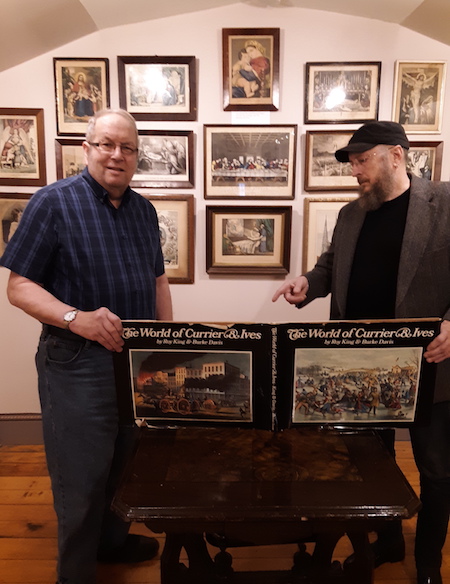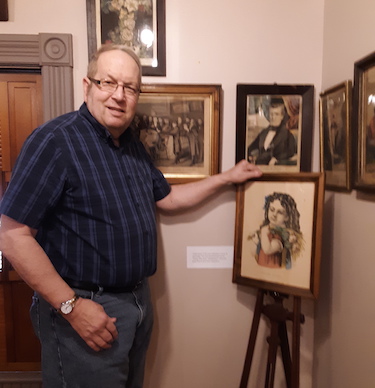New exhibit at Cobblestone Museum features prints more than a century old
Museum welcomes visitors to see display of ‘Americana’

Photos by Ginny Kropf: Doug Farley, left, director of the Cobblestone Museum, and Bill Lattin, former director, show a giant book of Currier and Ives prints which is part of a Currier and Ives exhibit now on display at the Cobblestone Museum’s art gallery.
CHILDS – After being limited for the past year due to the Covid pandemic, the Cobblestone Society Museum has decided to resume programming with an exhibit of Currier and Ives prints in their art gallery.
Director Doug Farley said he and former director Bill Lattin were talking recently about ways to increase visitation in the off season.
“This building is heated all year, unlike the other buildings in the Cobblestone Complex, and it has a public restroom, so it made sense to use it during the fall and winter,” Farley said.
They developed a plan to keep exhibits up year-round for a couple of years, he said. After the Currier and Ives exhibit is taken down in September, local artist Tom Zangerle of Medina will have a one-man show of his paintings through next spring. He will also have things for sale, Farley said.
“It’s good to give local artists a chance to show their works,” Farley said.
Lattin said the next exhibit after Zangerle’s will likely be of a historic nature.
Of the 75 prints hanging now in the gallery, 95 percent belong to Lattin’s collection of more than 200 Currier and Ives prints, and the other five percent are the museum’s.
“Currier and Ives is certainly Americana,” Lattin said.
He explained Currier and Ives prints date from 1834 to 1907. He said Nathanial Currier established his printing business in 1834. In 1867, he took on a partner, James Merritt Ives.
While Lattin is an avid antique collector, he prefers things from the 19th century, he said. He acquired his first Currier and Ives print of President Garfield in the late 1950s as a gift. It was colored, and he explained if Currier and Ives prints are colored, they were colored by hand.

Doug Farley, director of the Cobblestone Museum, stands next to one of the most popular Currier and Ives’ prints, “Little Daisy,” which is part of an exhibit now on display at the Museum’s gallery.
Lattin also said Currier and Ives were way ahead of Henry Ford. They had long tables in their print shop and hired women to color the prints. One woman would have red watercolor and would color all the parts that should be red, then pass the print to the next woman, who might have the blue color. She would then pass it on to the next to paint the green parts. They had the original assembly line, Lattin said.
He said Currier and Ives appealed to a wide spectrum of the population.
“We normally think of Currier and Ives as pictures of bucolic countryside scenes, such as the Homestead in Winter,” Lattin said. “This collection is not what you’d expect. These prints are smaller and represent the prolific imagery they produced.”
His collection includes prints of political nature, religion, Temperance and death bed scenes which were popular in their day.
One of the most popular Currier and Ives prints was “Little Daisy,” which was given as a free gift to anyone who subscribed to Young Folks Gem Magazine, which was established in 1872. Lattin said he was at an antique mall in Salamanca a week ago the Little Daisy prints were selling from $40 to $60.
The exhibit is open by appointment only any time Monday through Saturday by calling (585) 589-9013. Evening or Sunday appointments may also be possible.







































































